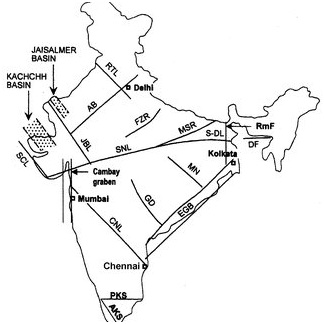- Seismic zone
- Seismic belt is an area of seismicity potentially sharing a common cause.
- Based on the past seismic history, Bureau of Indian Standards grouped the country into four seismic zones namely Zone-II, Zone-III, Zone-IV and Zone-V. Of all these four zones, Zone-V is the most seismic active region whereas Zone-II is the least.
|
|
Intensity on M.M Scale
|
- Zone-II (Low-Intensity Zone)
|
6 (or less)
|
- Zone-III (Moderate Intensity Zone)
|
7
|
- Zone-IV (Severe Intensity Zone)
|
8
|
- Zone-V (Very Severe Intensity Zone)
|
9 (and above)
|
- Indian Regions under the Seismic zones
- Zone-V covers entire northeastern India, some parts of Jammu and Kashmir, some parts of Ladakh, Himachal Pradesh, Uttarakhand, Rann of Kutch in Gujarat, some parts of North Bihar and Andaman & Nicobar Islands.
- Zone-IV covers remaining parts of Jammu & Kashmir, Ladakh and Himachal Pradesh, Union Territory of Delhi, Sikkim, northern parts of Uttar Pradesh, Bihar and West Bengal, parts of Gujarat and small portions of Maharashtra near the west coast and Rajasthan.
- Zone-III comprises of Kerala, Goa, Lakshadweep islands, remaining parts of Uttar Pradesh, Gujarat and West Bengal, parts of Punjab, Rajasthan, Madhya Pradesh, Bihar, Jharkhand, Chhattisgarh, Maharashtra, Odisha, Andhra Pradesh, Tamil Nadu and Karnataka.
- Zone-II covers remaining parts of the country.
|
